| Magnetic Fields in Galaxy Clusters |
|
This gas is mainly composed of hydrogen and helium. It is so hot that the electrons of its atoms have separated from the nuclei, and it is therefore called a plasma. This plasma emits X-rays.
Furthermore, the plasma is magnetised. This implies that some galaxy clusters also emit radio waves, so that they can be observed as radio haloes with radio telescopes. Figure 1 shows the galaxy cluster in the Coma constellation as seen in the optical, X-ray and radio regime.
| Figure 1: The galaxy cluster in the Coma constellation | ||
|---|---|---|
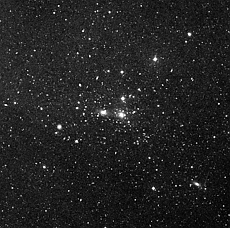 ESO,, Digitised Sky Survey |
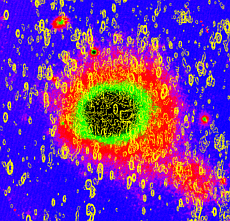 L. Feretti, IRB |
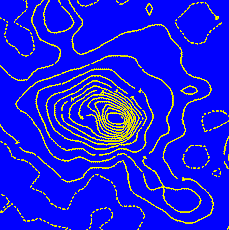 H. Lesch, USM |
| The left panel shows an optical image of Coma. Almost all objects on this image are galaxies. The X-ray image does not show individual galaxies, but only the plasma in between. Therefore, an image taken with the X-ray satellite ROSAT (centre panel) shows the galaxy cluster as one coherent object. The X-ray intensity is encoded by the colours from blue (no emission) through red and green up to black (intense X-ray emission). The yellow lines superposed are radio contours. If all individual radio sources are removed from that image, a diffuse image of the cluster in the radio regime results (right panel). | ||
Magnetic fields in galaxy clusters do not only show up in the radio regime. A magnetised plasma is birefringent, which means that the orientation of linearly polarised light is rotated by the plasma. LCD displays operate in a similar way, except that the birefraction is realised by liquid crystals rather than magnetic fields. The rotation of the polarisation orientation by a magnetised plasma is called Faraday rotation. The strength of this effect depends on the density of the plasma, on the strength of the enclosed magnetic field and on the length of the light path through the magnetised plasma. The Faraday rotation can be measured in radio observations of objects behind galaxy clusters, whose light has to travel through the clusters to reach us. Such observations allow to estimate the magnetic field strength in galaxy clusters. Typical values so obtained are of order a micro-Gauss (about one millionth of the Earth's magnetic field). Figure 2 shows a number of such measurements in the Coma cluster.
| Figure 2: Measured Faraday rotation | |
|---|---|

|
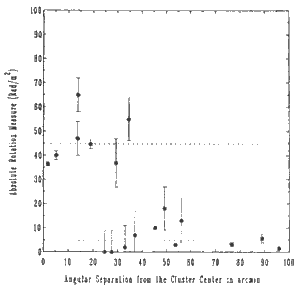
|
| Kim et al., 1990, Astrophysical Journal, 355, 29. | |
| The circles in the left panel show the measured Faraday rotation at the positions of several objects behind the Coma cluster. The radius corresponds to the strength of the measured rotation. Open and filled circles indicate the sense of the rotation. The right panel shows these measurements as a function of the distance to the cluster centre. The effect of the magnetised plasma in the cluster is clearly visible. Far away from the centre the plasma is so dilute that no rotation of the polarisation can be measured. | |
We know very little about the origin and the structure of these magnetic fields. We therefore attempt to understand with computer simulations how such magnetic fields could have formed. One idea is that an initially very weak magnetic field can be magnified during the formation and evolution of cosmic structure and, therefore, the galaxy clusters, to achieve the amplitudes observed today.
Once a plasma contains magnetic fields, they move with the plasma as if the magnetic field lines were frozen in.
Galaxy clusters evolve from the almost perfectly homogeneous early universe and collapse under the gravitational force of their gigantic masses to form relatively dense objects. Since the magnetic fields are frozen into the plasma, they are compressed with the plasma, and their strength increases as the plasma becomes more and more dense.
Galaxy clusters are embedded into the forming large-scale spider-web-like structure of sheets and filaments. This implies that the plasma streams primarily along such filaments, and thereby orders (bundles) the magnetic field frozen into it. This allows an even higher magnetic-field amplification during the collapse of galaxy clusters.
Powerful computers can simulate this process. The properties of the simulated magnetic field can then be compared with observations. For that purpose, synthetic observations are created from the simulations. If many simulations of that sort are carried out for different initial magnetic-field configurations, the permissible structure and strength of the initial, weak magnetic fields can be tested. This type of simulations is explained in Figure 3.
| Figure 3: Simulated formation of a galaxy cluster | |
|---|---|
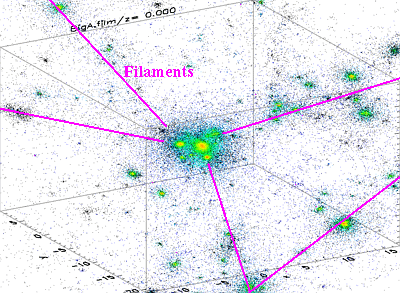
|
The figure shows the final result of a simulation. The three-dimensional distribution of particles is displayed for a fraction of the simulation volume. Black dots show the so-called Dark Matter. The plasma density is encoded by the colours from blue (very dilute) to red (very dense). A galaxy cluster has formed in the centre at a position where pronounced filaments (indicated by the pink lines) intersect. |
| Click on the image to start an animation of the cluster formation. | |
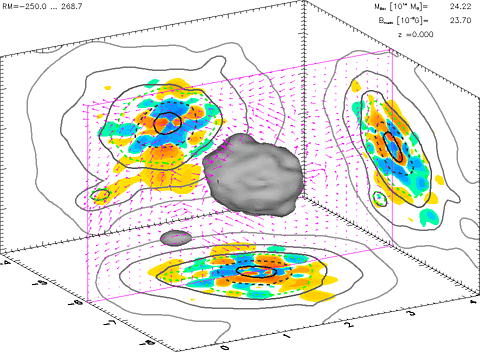
|
|
|
The figure shows the central portion of the
cluster simulation volume previously shown. Maps are projected
against the sides of the cube displayed, showing what observers
would see from the respective directions. The grey surface encloses
the part of the cluster in which the plasma density exceeds a
certain value. The pink arrows illustrate the magnetic field in a
cross section through the cluster. The grey lines on the projected
maps are density contours. The coloured regions indicate what
Faraday rotation could be measured if a radio source was located at
that position behind the cluster. Red and blue colours distinguish
the sense of the rotation; the amount of the rotation is indicated
by the brightness of the colour. Click on the image to start an animation of the cluster formation in that type of display. |
|
When compared to measurements, these synthetic maps reveal that simulated and real clusters have very similar properties. For instance, both show extended regions in which the sense of the Faraday-Rotation is unchanged, and others in which it fluctuates dramatically. Statistical tests quantitatively confirm the high degree of agreement between the synthetic maps and the measurements.
The galaxy cluster models so obtained are the first world-wide to contain realistic magnetic fields. They serve as the basis for further investigations into the role of magnetic fields in the process of cluster formation. Some of the processes going on in galaxy clusters can only be understood if magnetic fields are taken into account. Here, too, our models can be used to construct a more complete picture of the physical processes in these largest bound objects in the universe.